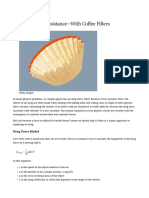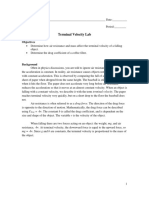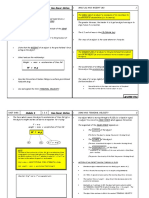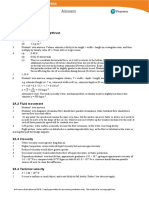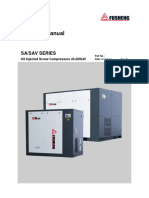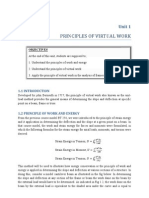MODULE 3.
Drag and Terminal Velocity
What you need to know:
● drag as the frictional force experienced by an object travelling through a fluid
● factors affecting drag for an object travelling through air
● motion of objects falling in a uniform gravitational field in the presence of drag
● terminal velocity
● techniques and procedures used to determine terminal velocity in fluids.
Explanation:
Drag:
Drag is the resistive force which acts on a body when it moves through a fluid. It causes the acceleration of falling objects
to reduce as the velocity increases.
Factors which affect drag include:
● Density of the fluid
● Coefficient of drag
● Cross-sectional area
● Velocity - drag is proportional to velocity squared
Falling objects and terminal velocity:
A falling object will experience two vertical forces, weight and drag. The force of the weight will remain constant
throughout the fall whereas drag will increase with increased speed:
● Instantaneous acceleration starts as g because weight is only force acting as velocity is 0
● Drag increases as the object falls due to increased speed
● Eventually the force of drag will be equal to the weight, the object will no longer accelerate as the net force is 0.
Terminal velocity is the velocity at which the drag force equals the weight, this means there is no resultant force so no
acceleration. This is the maximum possible speed which can be reached.
Example: Below is a graph of a skydiver jumping from a plane, use the graph to describe and explain the changes in velocity
experienced:
● At t=0, the skydiver leaves the plane with acceleration g as the only force acting upon it is weight
● As velocity increases, drag increases so the acceleration reduces
● Eventually, the drag equals the weight so terminal velocity is reached
● The parachute is opened and the drag is increased due to increased cross-sectional area, they decelerate quickly,
lowering the terminal velocity.
● Velocity drops to 0 as the skydiver hits the ground
Experiments to find terminal velocity:
An experiment can be carried out in a lab to calculate the terminal velocity of a mass as it falls through a fluid. Liquids
which are ideal include heavy oil and wallpaper paste - as they are denser making the object fall slower and therefore
makes determining speeds easier.
Equipment required: ball bearing, cylinder, clamps, elastic band, viscous liquid, stop watch, metre rule
� MODULE 3.2
Brief method:
● Set up a clamped cylinder filled with the liquid
● Drop the ball bearing into the liquid and start the stopwatch
● At set time periods put elastic bands onto the cylinder at the place where the ball is
● When the ball reaches the bottom, measure the distance between each elastic band
● Using the time period, find the velocity in between each section
● Plot a graph of velocity against time, they will be joined with as smooth curve, the
point where the gradient is 0 will be the terminal velocity
Improvements:
● Attach ball to ticker tape which punches holes at a set time interval and use the
distance between the dots to find the velocities
● Use a more viscous fluid to slow the ball more, improving accuracy of placement of
bands















